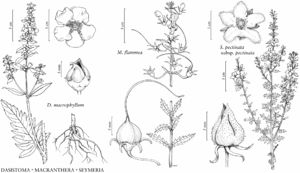familyOrobanchaceae
genusSeymeria
speciesSeymeria pectinata
subspeciesSeymeria pectinata subsp. pectinata
Difference between revisions of "Seymeria pectinata subsp. pectinata"
IllustratedEndemic
FNA>Volume Importer |
imported>Volume Importer |
||
| (One intermediate revision by the same user not shown) | |||
| Line 49: | Line 49: | ||
|publication year= | |publication year= | ||
|special status=Illustrated;Endemic | |special status=Illustrated;Endemic | ||
| − | |source xml=https:// | + | |source xml=https://bitbucket.org/aafc-mbb/fna-data-curation/src/2e0870ddd59836b60bcf96646a41e87ea5a5943a/coarse_grained_fna_xml/V17/V17_1009.xml |
|genus=Seymeria | |genus=Seymeria | ||
|species=Seymeria pectinata | |species=Seymeria pectinata | ||
Latest revision as of 19:24, 5 November 2020
Stems pubescent to villous. Capsules densely tomentose.
Phenology: Flowering and fruiting Jul–Oct.
Habitat: Pine-oak sandhills and scrub.
Elevation: 0–300 m.
Distribution
Ala., Fla., Ga., La., Miss., N.C., S.C.
Discussion
Plants of subsp. pectinata have been reported to parasitize Aristida stricta (Poaceae) and Quercus laevis (Fagaceae) (L. J. Musselman and W. F. Mann 1977). Greenhouse experiments demonstrate that plants of Seymeria pectinata are capable of parasitizing economically important southeastern trees (notably excluding Pinus) that are not known natural hosts, indicating pathogen potential and/or an incomplete host record for wild-collected plants (Musselman and Mann 1978).
Selected References
None.
Lower Taxa
None.
